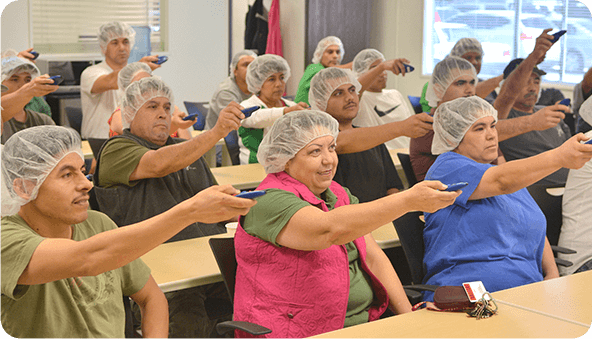Leverage New Learning Methods in Manufacturing

Today’s manufacturing workers are diverse, spanning generations, education, and cultures. Finding universal ways to effectively train all workers is key to maintaining quality and safety on the floor. Challenges posed by the worksites and diverse workforce make it difficult for manufacturers to stay up to date on the latest learning science. However, much of the corporate world is catching up to innovations in training, and a more interactive, learner-centric style of instruction is becoming widespread. As more industries begin to employ learning methods that appeal to younger generations, why not apply these same principles to manufacturing training, too?
Traditionally, manufacturing training has been top-down and long form. While this was efficient time-wise, the drink-from-the-firehose method is too passive to truly sink in for visual or kinetic learners. Plus, these methods don’t test comprehension or reinforce learning. Active learning, for example, uses strategies that gain and keep learners’ attention throughout the learning process. Subsequent reinforcement solidifies learning to become correct behavior. Other innovative methods based on recent science, such as micro-learning, learning moments, and storytelling have also proven to help make knowledge stick. In turn, the higher knowledge retention makes workers more confident on the floor, which makes them more likely to stick around.
Make Learning Active… Then Rinse & Repeat
Passive learning is, well, passé. Educators have known for years the best way to make people learn is engage them throughout the entire learning process. Unfortunately, a manufacturing supervisor rarely – if ever – has the luxury of formal teacher training. Fortunately, active learning techniques are easy to learn, with their focus on keeping learners engaged. One way is through gamification, assigning points and rewards based on learning and development, or quizzes that encourage interaction and provide knowledge checks. Remediation methods that ensure comprehension are also effective active learning tools.
It’s a fact that most training is forgotten. According to The Forgetting Curve phenomenon, people forget as much as 80% of what they have learned — unless the knowledge is programmatically reinforced. One way to reverse the Forgetting Curve is to promote micro-learning at strategic intervals. Long gone are the days when training was passive and took hours: sitting through a long lecture, watching a two-hour video, or reading a book-size manual for training. These days, even public school classrooms offer shorter lessons and interactive tools that resonate with younger generations, rather than relying on outdated teaching methods.
Deliver One Bite at a Time
The old ways simply don’t work anymore. Learning scientists have found people are more likely to remember and internalize a subject if they can digest the information in smaller parts. With the rise of the internet (and multi-tasking) our brains have gotten used to consuming “snackable content,” (think: texts and tweets), so it makes sense learning happens this way as well. (Remember the adage, How do you eat an elephant? One bite at a time).
Breaking down data is a useful memory strategy called “chunking” and why phone numbers are formatted like X-X-X. It’s easier to remember data when it’s grouped. Especially with today’s shortening attention spans, it makes sense to bite off only what you can chew.
Make Content Resonate
Teachers have long known that the best learning happens in “learning moments.” These are the “aha!” moments when a clear connection is made between new knowledge and practical application…. suddenly, the worker gets it. And — they’re less likely to forget what they have learned. On the manufacturing floor, this deep level of retention is critical, considering what’s at stake regarding food and workplace safety.
Learning moments can happen in the classroom and during individual training sessions, but they also happen on the job. In fact, every shift is an opportunity for several learning moments wherein training can be repeated and reinforced in the worker’s actual work environment. With the rise of floor-friendly mobile coaching apps, supervisors inexperienced with teaching can have a tool that gives them an edge. Mobile apps let them observe workers on the job and provide corrective action as needed — along with opportunities to deliver learning moments in real time. Learning moments have the most impact when related to real life situations.
Bring Important Concepts to Life
Another learning method, “storytelling” is more than a buzzword in education; it’s been used for millennia to organize and assign meaning to the world. It’s human nature to tell stories that explain, entertain, or connect, and as social creatures, we’re geared to pay attention to — and remember — stories. Stories also foster an emotional connection that helps information resonate. When knowledge makes an emotional impact, it gets stored in a different area of the brain where it can be easily recalled later. This is why stories often are used as mnemonic devices. Need to remember a long list? Make a narrative out of the items to help you remember them!
Stories also explain the why, in addition to the what. Humans love making connections. When people understand the reasoning behind a certain procedure, as well as the impact, knowledge becomes internalized. For example, when manufacturing workers learn why and how hand-washing can save lives by preventing specific foodborne illnesses, the everyday hygiene ritual becomes much more significant — and memorable.
Match the Method to the Content
As you begin testing out these training methods, you’ll discover not all strategies work well for every topic. You may find some topics work better than others due to the nature of the content. For example, straightforward or rote tasks like how to operate machinery are better delivered in a direct manner, whereas subjects like LOTO or food safety procedures may work best when presented as a story depicting real-life scenarios and consequences.
As in any training program, your mileage may vary depending on your industry, production goals, and workforce. But one thing is certain, no matter where you work: if the manufacturing industry wants to stay competitive in today’s market, manufacturing training methods must be updated in order to maintain excellence.
What kind of learning methods have you used in training that help with knowledge retention? We’d love to hear your thoughts below!





